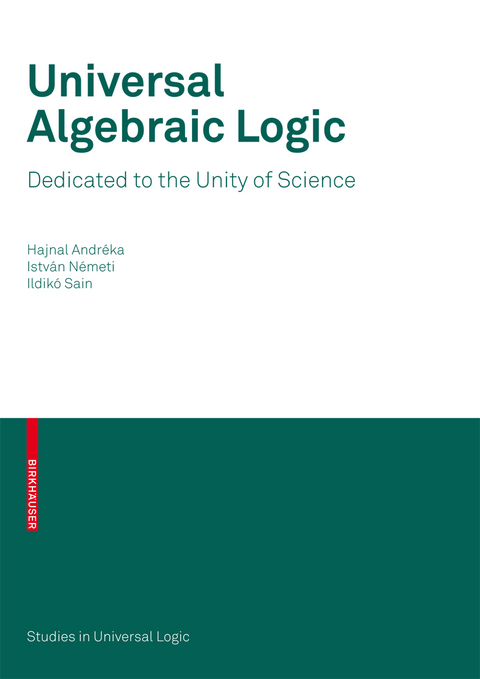
Universal Algebraic Logic
Springer Basel (Verlag)
9783764385057 (ISBN)
The three main themes of this book are (i) universal logic and the question of what logic is, (ii) universal algebraic logic and duality theories between the world of logics and the world of algebra, and (iii) algebraic logic proper including algebras of relations of various ranks, Tarski's cylindric algebras, relation algebras, Halmos' polyadic algebras and other kinds of algebras of logic. Besides Tarskian algebraizations of logics, category theoretical perspectives are also touched upon. Following the Tarskian tradition, besides the connections between logic and algebra, related logical connections with geometry and eventually spacetime geometry leading up to relativity are also part of the perspective of the book. An introductory chapter contains the necessary algebraic basics, this can be used in its own right as a quick introduction to universal algebra.
1. Introduction.- 2. Notation, elementary concepts: 2.1 Sets, classes, tuples, simple operations on sets.- 2.2 Binary relations, equivalence relations, functions.-2.3 Orderings, ordinals, cardinals.- 2.4 Sequences.- 2.5 Direct product of families of sets.- 2.6 Relations of higher ranks.- 2.7 First-order logic (FOL).- 3. Basics from universal algebra: 3.1 Examples for algebras.- 3.2 Building new algebras from old ones (operations on algebras): 3.2.1 Subalgebra.-3.2.2 Homomorphic image.- 3.2.3 Cartesian product, direct decomposition.- 3.2.4 Subdirect decomposition.- 3.2.5 Ultraproduct, reduced product.-3.3 Variety characterization, quasi-variety characterization.- 3.4 Discriminator varieties.- 3.5 Boolean algebras.- 3.6 Boolean algebras with operators.- 4. General framework for studying logics: 4.1 Defining the framework.- 4.2 Concrete logics in the new framework.- 4.2.1 Distinguished logics.- 4.2.2 The finite variable fragment of FOL. Finite model theory.- 4.2.3 Summary.- 4.2.4 Solutions for some exercises of subsections 4.2.1 and 4.2.2.- 5. Bridge between the world of logics and the world of algebras: 5.1 Fine-tuning the framework.- 5.2 Algebraic characterizations of completeness and compactness properties.- 6. Generalizations.- 7. Further equivalence results (definability, interpolation, omitting types) 8. New kinds of logics 9. The guarded fragment and its finite variable hierarchy.- 10. Distinguished algebras of logic: 10.1 Cylindric algebras.- 10.2 Relation algebras, substitution cylindric algebras, polyadic algebras.- 10.3 Relativization. The non-square approach to ``taming logics''.- 10.4 Brief return to guarded fragment and related positive results.- 11. Applications of the algebraic results to logic (via our bridge).- 12. Connections with set theory and foundational thinking.- 13. Connections with abstract model theory.- 14. Extending the bridge to including logic of spacetime, connections with relativity.- 15. On the problems in the books Henkin-Monk-Tarski: Cylindric Algebras Parts I,II and Henkin-Monk-Tarski-Andreka-Nemeti.- Some further problems.
| Erscheint lt. Verlag | 23.7.2021 |
|---|---|
| Reihe/Serie | Studies in Universal Logic |
| Zusatzinfo | Approx. 260 p. |
| Verlagsort | Basel |
| Sprache | englisch |
| Themenwelt | Mathematik / Informatik ► Mathematik ► Allgemeines / Lexika |
| Mathematik / Informatik ► Mathematik ► Algebra | |
| Mathematik / Informatik ► Mathematik ► Logik / Mengenlehre | |
| Schlagworte | Cylindric Algebras • Denotation • Duality theories • Lindström-type theorems • Logic, algebra, geometry triad • Logic with semantics • Mathematische Logik • Meaning algebras • Semantical algebraizable logics • Spacetime geometries • Syntax-semantics duality • Universal logic |
| ISBN-13 | 9783764385057 / 9783764385057 |
| Zustand | Neuware |
| Informationen gemäß Produktsicherheitsverordnung (GPSR) | |
| Haben Sie eine Frage zum Produkt? |
aus dem Bereich


